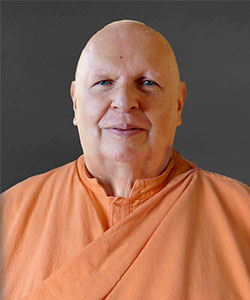The seventeeth in a series of talks by Swami Nirmalananda Giri (Abbot George Burke) on the Bhagavad Gita, India’s most famous scripture: the unforgettable dialog between Sri Krishna and Arjuna about the essence of spiritual life.
In this talk, starting with Chapter 4:01, Swamiji discusses what Krishna says is the “Eternal Yoga taught from the beginning,” shares stories of Anandamayi Ma, and discusses how God incarnates, plus other aspects of Krishna’a teachings in the Gita.
For those wishing to make a deeper study of the Gita, Swamiji’s commentary on the Gita, The Bhagavad Gita for Awakening: A Practical Commentary for Leading a Successful Spiritual Life can be found at Amazon.com.
Here are the Gita verses (4:01–4:06) covered in this talk:
The Holy Lord said:
This eternal yoga I taught to Vivaswat, Vivaswat taught it to Manu, and Manu taught it to Ikshwaku. (4:1)
Thus, handed down in succession, the royal seers knew it. After a long lapse of time, this yoga was lost here on earth. (4:2)
This ancient yoga is today declared by me to you because you are my devotee and friend. This secret is supreme indeed. (4:3)
Arjuna said:
Your birth was later, and Vivaswat’s birth was earlier. How then should I understand that you taught this in the beginning? (4:4)
The Holy Lord said:
Many of my births have passed away, and also yours. I know them all; you do not know them. (4:5)
Although birthless and imperishable, although the Lord of all beings, controlling my own prakriti, I come into manifested being by my own power of maya. (4:6)
Here are the main points from this talk: What is Eternal Yoga.
- Introduction to the Talk: Swami Nirmalananda introduces his translation of the Bhagavad Gita, highlighting its suitability for those new to or unfamiliar with Indian philosophy.
- Eternal Nature of Yoga: Yoga is described as eternal because it embodies the process of enlightenment inherent in the universe. It’s not just a practice but a revelation of the laws governing life and evolution.
- Historical Transmission: The ancient yoga was taught by Krishna to the sage Vishnu, then to Manu, and subsequently passed down through a lineage of sages, emphasizing the importance of historical continuity in spiritual teachings.
- Royal Sages (Rishis): The Rishis were not just scholars but perfected yogis who understood truths through their own yoga practice, not merely through learning.
- Loss and Recovery of Yoga: Over time, this knowledge was lost due to the world’s nature of forgetfulness, but it can be regained through cultivating higher consciousness and intuition.
- Personal Experience with the Gita: Swamiji shares his initial experience with the Gita felt like a remembering of known truths, rather than learning new information.
- Divine Relationship: Krishna reveals this ancient yoga to Arjuna because he is both a devotee and a friend, underlining the personal relationship one can have with the divine.
- Secrecy and Supremacy of Yoga: Yoga is described as both the highest knowledge and the most secret knowledge, known to very few.
- Arjuna’s Question on Krishna’s Teachings: Arjuna questions how Krishna, born later, could have taught yoga to Vivaswat, illustrating the challenge of comprehending divine timelessness.
- Dealing with Divinity: The talk touches on human reactions to divine presence, using the example of Ma Anandamayi’s unpredictable behavior, showing how divine beings interact in ways beyond human expectations.
- Karma and Interaction with Divine Figures: Swamiji warns about the significant karma one creates when interacting with divine or enlightened beings, emphasizing the need for respect and openness.
- Manifestation of Avatars: Krishna, as an avatar, has knowledge of all his incarnations, which contrasts with the human experience of forgetfulness.
- Purpose of Divine Manifestation: Krishna manifests when righteousness (Dharma) declines, to re-establish order, illustrating the divine intervention in human affairs.
Below is an audio version of this talk from our Gita Talks Podcast

Swami Nirmalananda Giri (Abbot George Burke)
Swami Nirmalananda Giri, founder of Light of the Spirit Monastery, has spent over six decades immersed in the study and practice of Yoga and and the spiritual traditions of East and West. He is the author of more than 30 books on meditation, practical spiritual life and Sanatana Dharma. Learn more »
